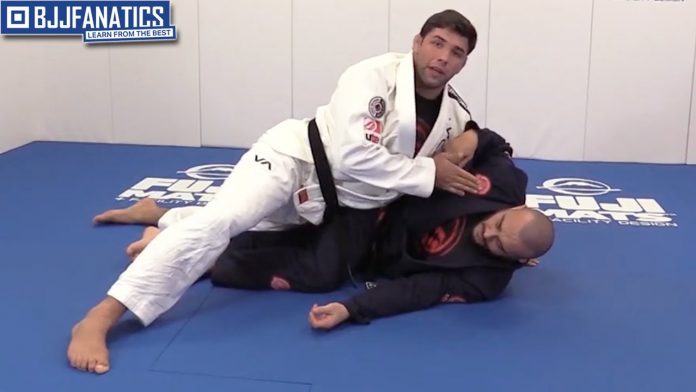
Throughout the years in Jiu-Jitsu, I’ve found that one thing keeps repeating itself – simple things work. When we come to think about it, they tend to work because we can understand them, not because they’re better than complicated things. It is just easier for the majority of people to get the why behind simple stuff. And, when you’re up against a daunting grappling task, like passing someone’s guard, simple is exactly what you need. In fact, guards are arguable the most complicated positions to play in BJJ. With that in mind. using simple ways to get past them, should work best. Take, for example, the BJJ folding pass.
Occam’s razor states that the most obvious solution is often the right one. In terms of passing the guard, we could say that the simplest thing is the most obvious one, hence, it should be the correct one as well. Passing someone’s guard in Brazilian Jiu-Jitsu means getting past their legs. Given the number and nature of guards, that is usually highly challenging. However, the goal is easy- if you make the legs go one way, you can easily go the other. Moreover, if you pin the legs completely, you can go wherever you choose. This is where the BJJ folding pass comes in to play.
BJJ: It is All About The HIps
Hips, hips, hips. Forget salsa dancing and the likes. Nobody has hips as BJJ players do. In fact, if ever the phrase “it is all about the hips” was true for something, it is Brazilian Jiu-Jitsu. The hips are everything in BJJ, whether you’re on the offensive, defensive, top, bottom, or any other position. How d you finish an armbar? How d you escape mount? What about passing the guard? Or retaining the guard, for that matter? In each one of these examples (and there are countless more) the hips are the main thing that makes everything work. As such, they’re the one body part, you want to contend with in order to beat your opponent’s game.
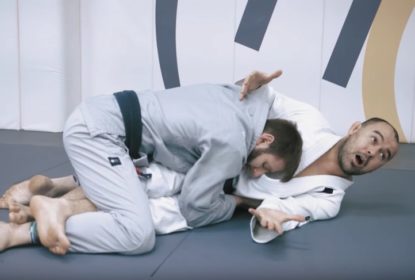
Speaking of variety, Ryan’s principle works against pretty much any open gaurd out there. Why? well if you manage, in any way, sort or form, to make the knees and toes point in the same direction, you have indirect control over an opponent’s hips. In other words, you’ve used the legs as levers, to pin the hips of the opponent to one side. It is just easier to remember knees and toes away, rather than thinking of elvers while you’re passing guards. That is precisely why the BJJ folding pass is so powerful in both Gi and No-Gi.
The Power Of The BJJ Folding Pass
You can do the BJJ folding pass against a whole myriad of open guards. One reason why it is simple is that it only has a few steps. On the plus side, the BJJ folding pass is a pressure pass, meaning you get to rest along the way, instead of having to explode past the legs. In fact, you absolutely have to wait and “cook” your opponent’s for a while, passing whenever you decide they’ve had enough. Isn’t that what BJJ is all about?
In fact, if you think about the BJJ folding pass, thing leg drag. The reason why the folding pass works better is that you get to trap both legs with your pressure, instead of having one behind your hip. That top leg is exactly why people wiggle out of a leg drag. in a folding pass, you want both your opponent’s knees together, with the legs to the side. Of course, the goal is to have the legs on the mats, with your hips over the opponent’s thighs. The main difference with a leg drag is that with the folding pass, you have both their legs in between your legs. This helps pin your opponent with ease, while you decide where to go (unlike the leg drag where you usually pass to one side only).
Entering the BJJ folding pass is actually something you shouldn’t learn as a technique. The pas will work again so many different types of guards if you just understand what you want to accomplish with it. After all, entries are different every time you do them, so there’s no point in bothering with learning specifics. As long as you pin both legs in between your legs, and place your hips high over the opponent’s top thigh, you’re ready to start pressuring a guard pass.
Essentials For The Gi
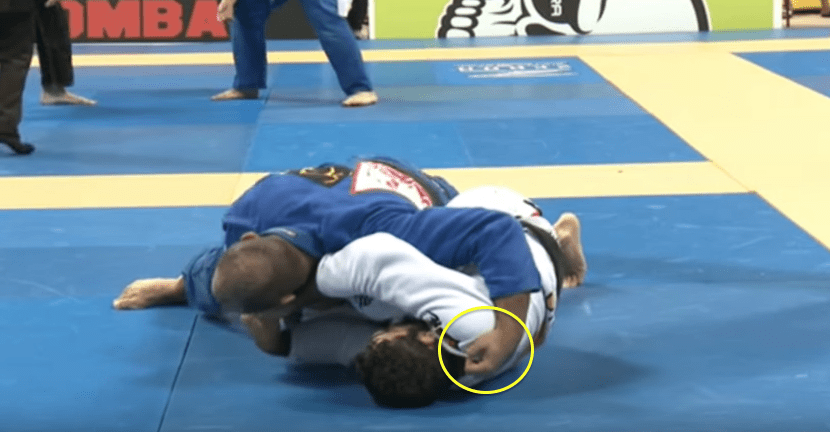
The moment you get the hips in place, you should be hunting for an underhook. there’s only one side to look for it, as the opponent will be lying on their side. The goal is to get an underhook and establish a grip on the back of the gi collar. This will provide you with a great handle, and even more pressure because you can force their shoulder to the ground. This puts a twist to the spine, taking away any posture an opponent might have. Even better, you can accentuate this by gripping the front of the collar with your other arm, and pulling your elbow towards your hip. Given that the base is completely destroyed by the BJJ folding pass pressure position, you now have complete control.
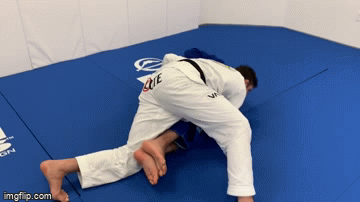
No-Gi BJJ Folding Pass
Without the Gi, the BJJ folding pass is still a great option, you just need to fine-tune the grips. It is not just about the handles on the collar, but also on the Gi pants. here’s where entering perfectly into the position becomes even more important. That means, when you start learning the BJJ folding pass, pay attention to where your hips are in relation to the opponent’s thighs. That is crucial.
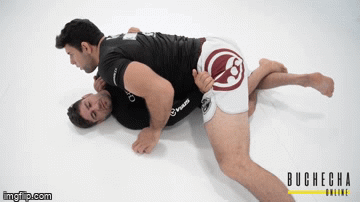
Final Words
The BJJ folding pass is powerful because it pins the opponent’s hips in place. Without the hips, there’s no guard retention or recovery. Moreover, it utilizes pressure from your own hips, which, as we saw, is immense in BJJ. Plus, you get to pass in different directions, ending in a different position.. And you get to do it with and/or without the Gi. What could be better?


![Darce Choke Encyclopedia – Origins, Mechanics and Variations [2025] BJJ, choke, Brabo, BJJ Darce Choke, D'arce Choke, Darce BJJ Choke](https://bjj-world.com/wp-content/uploads/2017/11/JungPoirierLeeYahoo-218x150.jpg)









![Closet Closed Guard Craig Jones DVD Review [2025] Closet Closed Guard Craig Jones DVD Review](https://bjj-world.com/wp-content/uploads/2025/03/closet-closed-guard-craig-jones-dvd-review-218x150.png)
![Xanadu Back Takes Levi Jones-Leary DVD Review [2025] Xanadu Back Takes Levi Jones-Leary DVD Review](https://bjj-world.com/wp-content/uploads/2025/03/xanadu-back-takes-levi-jones-leary-dvd-review-218x150.png)

![No-Gi Grapplers Guide To Front Headlock Joel Bane DVD Review [2025] No-Gi Grapplers Guide To Front Headlock Joel Bane DVD Review](https://bjj-world.com/wp-content/uploads/2025/03/no-gi-front-headlock-joel-bane-dvd-review-218x150.png)

![Get Off My Legs Gringo Craig Jones DVD Review [2025] Get Off My Legs Gringo Craig Jones DVD Review](https://bjj-world.com/wp-content/uploads/2025/03/get-off-my-legs-gringo-craig-jones-dvd-review-218x150.png)
![Jett Thompson Master Ankle and Aoki Lock DVD Review [2024] Jett Thompson Master Ankle and Aoki Lock DVD Review](https://bjj-world.com/wp-content/uploads/2024/09/jett-thompson-master-ankle-and-aoki-lock-dvd-review-324x235.png)

![360 Degrees Guard Retention Thiago Abud DVD Review [2024] 360 Degrees Guard Retention Thiago Abud DVD Review](https://bjj-world.com/wp-content/uploads/2024/10/360-degrees-guard-retention-thiago-abud-dvd-review-100x70.png)

![Charles Allan Price Building Workouts For BJJ DVD Review [2024] Charles Allan Price Building Workouts For BJJ DVD Review](https://bjj-world.com/wp-content/uploads/2024/09/charles-allan-price-building-workouts-for-bjj-review-100x70.png)
![Wristlocks From The Top Pete Letsos DVD Review [2025] Wristlocks From The Top Pete Letsos DVD Review](https://bjj-world.com/wp-content/uploads/2025/01/wristlocks-from-the-top-pete-letsos-dvd-review-100x70.png)

![Advantage Over Time Outside Passing Jozef Chen DVD Review [2025] Advantage Over Time Outside Passing Jozef Chen DVD Review](https://bjj-world.com/wp-content/uploads/2025/03/outside-passing-jozef-chen-dvd-review-100x70.png)

![The Whole Omoplata Enchilada Lyanne Perez DVD Review [2024] The Whole Omoplata Enchilada Lyanne Perez DVD Review](https://bjj-world.com/wp-content/uploads/2024/11/whole-omoplata-enchilada-lyanne-perez-dvd-review-100x70.png)


![Creating Back Exposure Luke Griffith DVD Review [2025] Creating Back Exposure Luke Griffith DVD Review](https://bjj-world.com/wp-content/uploads/2025/01/creating-back-exposure-luke-griffith-dvd-review-100x70.png)
![Assassin Choke Baret Yoshida DVD Review [2024] Assassin Choke Baret Yoshida DVD Review](https://bjj-world.com/wp-content/uploads/2024/10/assassin-choke-baret-yoshida-dvd-review-100x70.png)

![Bricks Kesa Gatame System Jeremy Brick DVD Review [2025] Bricks Kesa Gatame System Jeremy Brick DVD Review](https://bjj-world.com/wp-content/uploads/2025/02/bricks-kesa-gatame-system-jeremy-brick-dvd-review-100x70.png)

![Reverse Armlock Magid Hage DVD Review [2024] Reverse Armlock Magid Hage DVD Review](https://bjj-world.com/wp-content/uploads/2024/12/reverse-armlock-magid-hage-dvd-review-100x70.png)


![Reverse Arm Bar System Andrew Kerfoot DVD Review [2024] Reverse Arm Bar System Andrew Kerfoot DVD Review](https://bjj-world.com/wp-content/uploads/2024/10/reverse-arm-bar-system-andrew-kerfoot-dvd-review-100x70.png)
![Highlight Hip Throws Christian Ozbek DVD Review [2025] Highlight Hip Throws Christian Ozbek DVD Review](https://bjj-world.com/wp-content/uploads/2025/01/highlight-hip-throws-christian-ozbek-dvd-review-100x70.png)

![Heavy Top Game Fabiano Scherner BJJ DVD Review [2025] Heavy Top Game Fabiano Scherner BJJ DVD Review](https://bjj-world.com/wp-content/uploads/2025/01/heavy-top-game-fabiano-scherner-bjj-dvd-review-100x70.png)
![No-Gi Pressure Mastery JT Torres DVD Review [2024] No-Gi Pressure Mastery JT Torres DVD Review](https://bjj-world.com/wp-content/uploads/2024/10/no-gi-pressure-mastery-jt-torres-dvd-review-100x70.png)

![Leg Lock Stock And Barrel Taylor Pearman DVD Review [2025] Leg Lock Stock And Barrel Taylor Pearman DVD Review](https://bjj-world.com/wp-content/uploads/2025/03/leg-lock-stock-and-barrel-taylor-pearman-dvd-review-100x70.png)

